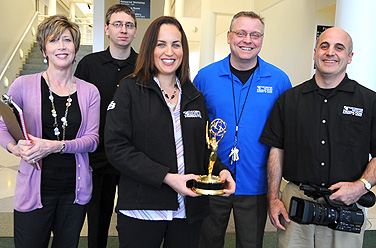Close Up
Group puts campus on video screen

The cast of characters that makes up the Center for the Arts video production group: from left, Regina Ticco; Chris Weber; Jamie Enser, holding the group’s recent New York Emmy® award; Boone Enser; and Paul Calandra. Photo: NANCY J. PARISI
-
 Print
Print -
 Comments
Comments
-
Multimedia

Watch the Center for the Arts video production group’ highlight reel.
For decades, UB has had a reputation for creating experimental film and video through the Department of Media Study. Turning the camera on the campus itself, however, was another story—until recently.
UB now is playing on a computer screen near you as YouTube and other web links are being filled with visions of the university, from events on campus to researcher interviews to school and department spotlights.
Fade in on the Center For the Arts (CFA). Cut to a moving shot down the basement stairs and along the hall into the bowels of the Mainstage theater where the video production group is at work in three separate editing rooms. In one room, a Distinguished Speakers Series video is being edited. A piece for External Affairs is being edited in another. And in the third, Boone Enser, director of media, is piecing together a behind-the-scenes look at the CFA’s collaborative production of “Something So Right,” a musical, dance and theater experience told through the words and music of Paul Simon. Enser’s got one eye on the scene while discussing with a videographer how best to capture a shot showing the solar panel field on a snowy campus site.
Jamie Enser, director of production operations, enters the scene. Pan to close-up of the Ensers.
JAMIE: We’ve lived all over the country—Orlando, Atlanta, Los Angeles—both of us having worked for national television networks.
BOONE: We came back because we wanted to raise our family in Western New York, being in an environment where our kids (Madison, 7, and Juliana, 3) can know their grandparents.
It’s a boy-meets-girl story. He’s a young director at WGRZ-TV, Channel 2. She arrives there as a summer intern from Ithaca College majoring in TV and radio. They click, eventually departing for greener television pastures. They go to Atlanta for the 1996 Summer Olympics. Jamie lands a job there as video journalist with CNN, Boone gets a call to help launch a new sports network in Orlando, The Golf Channel. They both wind up at the Nickelodeon network, are transferred to Los Angeles and then decide that they’ve had enough traveling. The Western New Yorkers head back home. She answers an ad for a production director at the CFA. He joins later, initially as a freelancer on productions.
JAMIE: Tom Burrows (CFA executive director) always wanted to include a video-production aspect to the performing arts. When he looked at my background, he felt that he could finally start doing that. So we’ve been capturing performances and producing arts-related content, using video as a way to bring the arts to a larger audience—and a lot of different purposes ever since.
The first project was a virtual tour of the CFA. From there, they began to generate original productions, the first being Music is Art Live @ The Center, a series that ran for 41 half-hour episodes on area commercial and PBS affiliates. The show spotlighted a wide spectrum of local musical and visual artists.
BOONE: The unit evolved to the point where if the CFA was underserved in video production, the university was extremely underserved. We found ourselves working with Athletics, External Affairs and different schools. Now we’re branching out into different academic units that need good video.
JAMIE: We’re finding that there is a big demand for short videos—one to three minutes in length—that can be posted on YouTube and embedded on a website.
BOONE: A big chunk of our job now is helping to educate the educators, helping to show them that this is a good way to tell their story. It might be a three-minute piece, a one-minute piece, or a 26-minute documentary. There are thousands of great stories about the university that are not being told.
Also part of the core video production team are Regina Ticco, producer; Chris Weber, editor; and Paul Calandra, videographer, along with the production expertise of the CFA technical staff.
Since 2006, the group has won 14 Tellys, an international award honoring TV and video productions, including one for “The Mystical Arts of Tibet” documentary from the Dalai Lama’s visit to UB in 2008 for which they engaged actor Richard Gere.
This month, the group won a coveted New York Emmy® award for the documentary, “Industrial Engineers Make a Difference” featuring several UB IE alumni in workplaces across the country.
BOONE: The next big push for the Internet is video—the bandwidth is finally catching up to it. Video is an easy way to deliver a good message. It comes back to the old standard: If you tell a good story, people are going to enjoy it.
Dissolve to montage of the various UB stories currently being shot or edited. Fade out.

Reader Comments